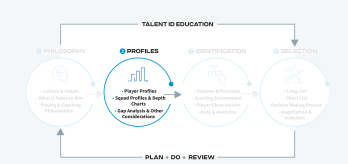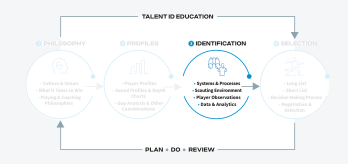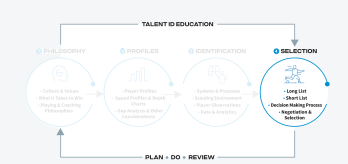Talent identification is vital for building a successful football program. It forms a foundation that supports other areas, such as talent development and national teams, enabling them to excel. Relating to Module 1, an organisation, grounded in its football philosophy, should have a clear understanding of how it wants to play (i.e., playing philosophy). This second module outlines steps to develop player and squad profiles as well as depth charts of players in teams. It also details gap analysis and other considerations to facilitate the talent identification process for a football organisation.
Why is this dimension important?
Profiles involve determining what is required in a player and squad to perform at the highest level and achieve success for a football organisation. Profiles refer to the characteristics and attributes that define the type of players desired to execute the playing style of an organisation, based on their philosophy. It also includes profiling squads and creating depth charts to better understand current resources and its gaps.
Profiles play a pivotal role in the talent identification process as they provide a structured framework for understanding the needs of an organisation, enabling informed decisions in player identification and selection processes to shape squads for success. Once an organisation has a clear understanding of how it wants to play (i.e., playing philosophy), an organisation can define player profiles, encompassing both subjective and objective technical, tactical, physical, psychological, and social attributes desired. Relatedly, profiling squads and creating depth charts enables the organisation to grade and rank current players, compare them to external competitors, and consequently consider their needs to ultimately facilitate the talent identification process.
To successfully create and develop profiles, sufficient time must be devoted to developing a comprehensive understanding and analysis of both current and desired players and squads. Having profiles that align with an organisations football philosophy is essential for achieving a cohesive approach to talent identification that support long-term success.
How do you achieve success?
Create and implement player profiles
The focus of player profiles is to establish a detailed understanding of the characteristics and attributes required for players of a football organisation to succeed at the highest level. The comprehensive understanding of desired players ensures alignment in the talent identification process and with the organisation’s playing style and football philosophy.
-
Are player profiles age and maturation specific?
-
Are player profiles position specific?
-
Are player profiles gender specific?
-
What is measured and how (e.g., key performance indicators)?
-
Discuss how players with potential should be technically, tactically, physically, psychologically, and socially profiled via both objective and subjective measures to gauge their suitability.
-
Encourage stakeholder engagement, particularly with researchers and specialists, to ensure profiles are research/insight informed.
-
Ensure player profiles are co-created with all stakeholders to highlight key characteristics for each gender, age group, and position.
-
MODULE 2 | PLAYER PROFILE – FOUR CORNER TEMPLATE: This template helps visualise a player’s key attributes. These are broken down into four corners: technical, tactical, physical and psychosocial.
-
MODULE 2 | PLAYER PROFILE – IN/OUT OF POSSESSION TEMPLATE: Rather than categorising attributes according to the four-corner method above, this template sorts a player’s criteria according to performance in and out of possession.
-
Developing the player of the future: Within this interview you can hear about insights from Arsène Wenger on key attributes a player must have to make it to the top of the game, which may consequently inform the creation of your player profiles.
-
How Australia use player profiles to identify talent and educate coaches: In this presentation, Football Australia’s Technical Director of Men’s Football and U-20 Head Coach, Trevor Morgan, explains how his association’s player profiles are shaping talent development.
-
Sofyan Amrabat – Player profile: Within this article you will find an in-depth analysis and player profile of midfielder Sofyan Amrabat from the FIFA World Cup Qatar 2022, which may help influence the creation of your own midfielder player profile.
-
Salma Paralluelo – Raider of the final third: Within this article you will find insights into winger Salma Paralluelo and her player profile from the FIFA Women’s World Cup 2023, which may assist you in the development of your own player profile.
-
Setting physical benchmarks across positions (FIFA WWC 2024): Within this article you will find the benchmarking of physical demands across positions from the FIFA Women’s World Cup 2023, which may support the creation of your own player profiles physical desirables.
Develop squad profiles and depth charts
The focus of squad profiles and depth charts involves comprehensively assessing and documenting the current pool of players and squads within a football organization by analyzing their abilities and performance levels. Effective benchmarking and grading of an organisation’s current squad and players ensures a clear understanding of how they measure up against set objectives, internal standards, and external competitors.
-
What does the football organisation currently have and how good is it?
-
Does the football organisation have any grading, ranking, and benchmarking (i.e., internally and externally)?
-
Do the squad profiles align with the playing philosophy?
-
Develop squad profiles and depth charts, which can create a better understanding of what the football organisation currently has within their pathway (e.g., grading and ranking).
-
Consider how it compares to other competitors (e.g., benchmarking).
-
Emphasise how benchmarks should be age, maturation, and position-specific, whilst external expertise and research would be used where appropriate.
-
MODULE 2 | SQUAD PROFILING PROCESS: This resource may be used to help analyse your current squad through a series of questions to assess and understand the current pool of players available.
-
MODULE 2 | DEPTH CHART – GRID VIEW: The Grid View template is a variation of a depth chart that helps visualise a squad’s distributions in a grid format.
-
MODULE 2 | DEPTH CHART – FIELD VIEW: The Field View template also visualises a squad’s distribution but presents the information in the context of the pitch.
-
Setting physical benchmarks across teams (FIFA WWC 2024): Within this article you will find the benchmarking of the team physical demands during the FIFA Women’s World Cup 2023, which provides a relevant benchmarking example to consider when developing squad profiles and depth charts.
Conduct gap analysis and other considerations
The focus of gap analysis and other considerations lies in understanding the specific needs of the football organisation based upon current resources available. A detailed gap analysis allows for the identification of areas where the organisation may be lacking, thereby facilitating the talent identification process to address those gaps.
-
What does the football organisation need?
-
What resources does the football organisation currently have?
-
Does the football organisation have age profiles?
-
What are the football organisation’s ‘elite’ player behaviours?
-
Outline what they are missing and, therefore, what they require to identify/develop based on contextual factors such as age, gender, and playing position. This can be based upon their squad profiles and depth charts
-
Encourage the football organisation to use player profiles, squad profiles, and depth charts to help form the process to determine the resources required
-
MODULE 2 | SWOT ANALYSIS: This template helps outline your organisations strengths, weaknesses, opportunities and threats, painting a broader picture of internal strengths and weaknesses.
Reflection checklist
The following reflection checklist will enable a football organisation to critically evaluate important components of profiles to facilitate the talent identification process:
Summary
-
To successfully create and develop profiles, sufficient time must be devoted to developing a comprehensive understanding and analysis of both current and desired players and squads
-
Asking key questions highlighted in each subdimension will aid the development of comprehensive player profiles, squad profiles and depth charts, and enhance the understanding of gaps and needs
-
Considering the various important factors involved in each subdimension will ensure that profiles enable informed decisions in player identification and selection processes
-
Use the various good practice examples, tools, and additional resourced embedded within this guide to develop your own profiles


















.variant64x64.png)
.variant348x164.png)